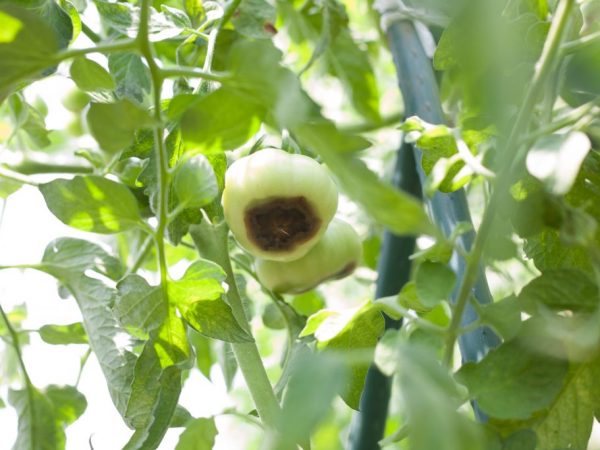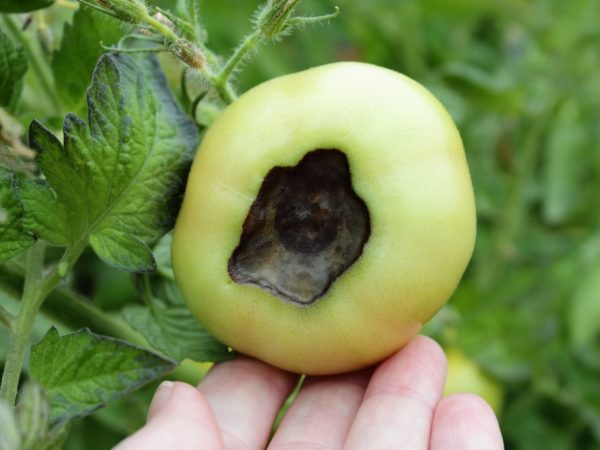How and how to treat brown rot in tomatoes
Tomatoes are one of the most beloved and popular crops among summer residents and gardeners in the post-Soviet space. According to statistics, a third of all vegetables are harvested from tomatoes. For each strip, a variety is selected that can withstand climatic conditions. But during the cultivation of the culture, the vegetable grower is faced with various difficulties and diseases, one of which is the brown rot of tomatoes.

Treatment of brown rot in tomatoes
All diseases affecting plants are infectious or parasitic in nature. They are caused by a variety of pathogenic microorganisms (viruses, bacteria, fungi). The grower needs to know full information about the disease in order to recognize it and begin effective treatment, only this way it does not spread to other tomato bushes.
Basic disease data
Some vegetable growers faced the following situation: initially, the fruit grows and gains weight normally, and then a heel appears around the stalk, which in a matter of days increases in size. This is the main sign that the plant is affected by a fungal disease. Brown rot is a disease that quickly destroys crops and spreads to other plants, so it is worth familiarizing yourself with the main characteristics:
- Tomato phomosis appears as a small spot at the base of the tomato.
- The next stage is the spread of rot from the stalk to all sides of the tomato.
- Modifications of the surface: it becomes lumpy, as pycnidia appear, the tissue in the lesions is easily pressed into the middle.
- Although the diameter of the spot that appears is not so large (on average 3 cm), the entire inner part of the fruit is completely spoiled and rotted.
- Brown rot can affect both young (still green) and more mature tomatoes, while green ones do not even ripen to a state of technical maturity. If the treatment was ineffective and the phomosis destroyed the fetus, it breaks off the stalk and simply falls off.
- The pathogen enters the bush through small mechanical damage.
- The most favorable environment for the development of the disease "Brown rot" is the high humidity of the environment, and the soil that is excessively fertilized with inorganic substances.
- The main sources of infection are previously contaminated seed material, natural phenomena: wind or rain.
Phomosis in tomatoes is very difficult to stop. If a bush becomes infected with this fungus, it is no longer realistic to save it.
Under these conditions, the gardener will have to completely remove the plants. This disease also affects potato tubers, so it is worthwhile to correctly delineate the planting area and in no case plant seedlings in the place where the potatoes previously grew.
Disease control methods
Since the pathogen is fungal in nature, it is necessary to stop the further spread of the disease, because it can affect not only tomatoes, but also other vegetables.

It is necessary to destroy the focus of the disease as soon as possible
For treatment, professional vegetable growers use special means that can effectively destroy harmful microorganisms. A good decision would be if the gardener takes preventive measures in advance, then you can not even treat the plants, because the fungus will not infect the culture.
Treatment
For medicinal purposes, both organic and inorganic drugs are used that destroy the focus of the disease. If these do not help, the vegetable grower will have to take drastic measures: complete removal of the plant. The whole process consists of:
- Directly treatment: treatment of a bush with young fruits with drugs (Bordeaux mixture) or a medicine based on copper oxychloride, it is also called HOM.
- If brown rot begins to appear during the growing season, you should immediately inspect the plants, collect and remove all rotten fruits so that the infection does not spread further.
After the infected plant has been eradicated from the site, it is necessary to immediately burn the leaves, stems and even infected fruits. In this way, the focus of the disease will be completely destroyed.
Preventive measures
- If tomatoes are planted in an open space, the soil is disinfected beforehand. If the planting takes place in a greenhouse, greenhouse coverings are additionally treated, since they also come into contact with the distributors and can become infected.
- Before sowing, the seeds are also processed: they are soaked in a weak solution of potassium permanganate. To do this, take a small amount of warm water and one match. The head of a match is moistened in water, dipped in crystals of potassium permanganate and then added again to water, obtaining a light pink solution. You can leave the seeds in it for several days for dressing.
- Inside the greenhouse (greenhouse), it is necessary to maintain normal and constant air humidity. If it is excessive, favorable conditions will be created for the development of harmful organisms.
- Tomatoes need fertilizing with nitrogen and organic fertilizers. Do not overdo it with fertilizers, as this will serve to develop the fungal microflora.
Conclusion
Disease "Brown rot" can be easily resisted if the grower strictly follows all agrotechnical requirements at every stage of plant development from the moment of sowing the seeds and right up to the final harvest.
Professionals warn that non-compliance with the rules leads to the fact that tomatoes are affected by various bacteria and insects, it is extremely difficult to solve this problem.


